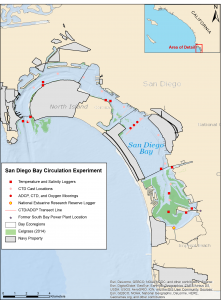As one of five major ports in California, San Diego Bay is an important hub for industry and commerce, as well as the U.S. Navy Pacific Fleet. The bay consists of nearly 11,000 acres of marine habitat for a diverse aquatic population that helps sustain various fauna that use the bay for breeding, rearing young, and migratory respite. Among the many organisms that call the bay home are sea turtles and the California Least Tern. As anthropogenic activities alter the landscape, environmental stresses put on these organisms have changed their migration and foraging patterns.
A collaborative project between SIO and SPAWAR SSC-Pacific is currently underway to improve upon the current understanding of the mechanisms driving San Diego Bay environmental conditions and circulation patterns to asses their role in ecological function of the bay. By assessing its modern hydrographic state, quantifying flow fields, and contextualizing the physical data with existing biological data, we hope to gain a better understanding of the system as a whole, which will ultimately allow for better stewardship of the resources that the bay provides.
A key focus of this project is shoal-channel interaction during the time period when the south bay becomes consistently saltier than the ocean (i.e. summertime in San Diego). This is intended to be a topic in Angelica’s dissertation and her summer internship with SPAWAR through the NREIP.

